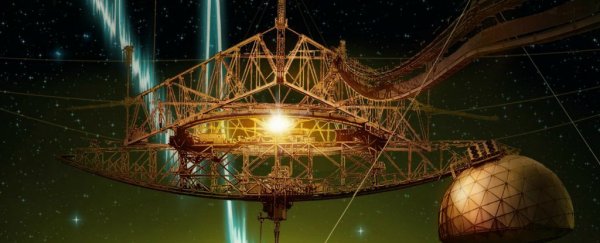Fast radio bursts (FRBs) are among the most explosive and mysterious signals ever detected from space. They only last milliseconds, but in that short period of time, they generate as much energy as the Sun does in an entire day. And we have no idea where they come from.
Until now, we've detected just a handful of the strange events, and only ever through radio wave emissions. But for the first time, researchers say they've now spotted a huge burst of gamma rays - high-energy waves on the opposite end of the electromagnetic spectrum to radio waves - that corresponds with an FRB.
If verified, it will provide the biggest clue to date as to the source of these mysterious signals.
FRBs are often called cosmic whistles, because we've only been able to 'hear' them with radio telescopes. Until recently, we've never caught sight of them across any other parts of the electromagnetic spectrum - they don't seem to emit X-rays, or visible light.
For the record, this is what an FRB sounds like:
Despite how explosive these events are, an FRB was only detected for the first time in 2007, and the signal was so intense and weird, it took years for researchers to agree that what they'd detected was actually a cosmological phenomenon, and not just a glitch in the instruments.
Since then, researchers have estimated that there are around 2,000 of these FRBs firing across the Universe every single day, but the tricky part is having a telescope pointed at the right place at the right time to detect them. As of February this year, we'd spotted just 17 of the events.
To figure out where they come from, astronomers have been desperately trying to find evidence of FRBs across other parts of the electromagnetic spectrum.
Now, a team from Pennsylvania State University, led by graduate student James DeLaunay, might have done just that, using NASA's Earth-orbiting Swift satellite.
On 4 November 2013, the satellite just so happened to be pointed at the same patch of sky as a radio telescope in Australia known as the Parkes Observatory.
On that day, Parkes detected an FRB. And after going back over the data, DeLaunay and his team realised that Swift had also detected a gamma-ray burst occurring at the same place and time.
"I started this search for FRB counterparts without expecting to find anything," said DeLaunay. "This burst was the first that even had useful data to analyse. When I saw that it showed a possible gamma-ray counterpart, I couldn't believe my luck!"
Researchers had predicted in the past that FRBs might also release gamma-rays, but no one had ever expected what DeLaunay and his team hd found.
The gamma-ray emission that accompanied FRB 131104 lasted 2 to 6 minutes - far longer than the millisecond duration of the radio emissions.
And the signal was a lot brighter than anyone had ever anticipated - the gamma-ray emissions outshone the radio emissions by more than a billion times.
This makes the events even more explosive than we'd imagined, and powerful enough to rival the cataclysmic power of supernovae - exploding stars.
It also provides some solid clues as to what kind of dramatic astronomical phenomenon might be behind FRBs.
Before this latest discovery, there were two general ideas about how FRBs might also produce gamma-rays.
One idea was that the signals were being caused by magnetic flares from magnetars - highly magnetised neutron stars that are the dense remnants of collapsed stars.
The other idea was that FRBs occur when two neutron stars collide to form a black hole.
This latest data leans towards the later.
"The energy release we see is challenging for the magnetar model unless the burst is relatively nearby," said one of the team, Kohta Murase.
"The long timescale of the gamma-ray emission, while unexpected in both models, might be possible in a merger event if we observe the merger from the side, in an off-axis scenario."
But, even more tantalisingly, it also suggests that there might be a third option.
"In fact, the energy and timescale of the gamma-ray emission is a better match to some types of supernovae, or to some of the supermassive black hole accretion events that Swift has seen," added one of the researchers, Derek Fox.
"The problem is that no existing models predict that we would see an FRB in these cases."
There's still a lot we don't know. And this latest gamma-ray burst discovery still needs to be verified before we get too excited - there has been one false alarm in the past about a counterpart to an FRB.
But experts are cautiously excited.
"This one might finally be the real thing," astronomer Katie Mack from the University of Melbourne, who wasn't involved in the study, wrote on her Facebook page last night.
"If it pans out, it tells us that FRBs are INCREDIBLY intense explosions from the very distant universe. Think: something along the lines of an exploding star in another galaxy, billions of years ago, with the light only reaching us now."
There might even be multiple types of FRBs out there to uncover.
The next step is for researchers to search for any evidence of these events occurring across any other parts of the electromagnetic spectrum, such as through long-lived X-ray or optical emissions.
And now the Penn State team is now setting up to do just that.
"Ideally, these campaigns would begin soon after the burst and would continue for several weeks afterward to make sure nothing gets missed," said DeLaunay. "Maybe we'll get even luckier next time."
We're looking to seeing what the team finds next.
The paper has been published in Astrophysical Journal Letters, and can be freely accessed at arXiv.org.
